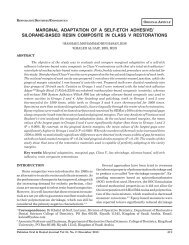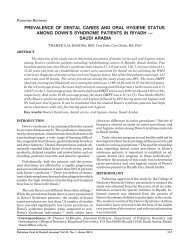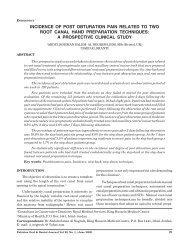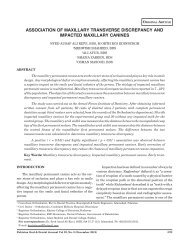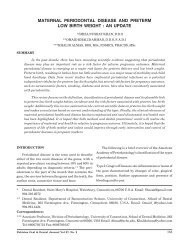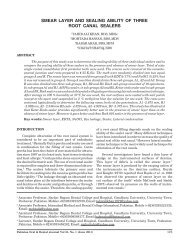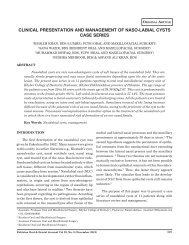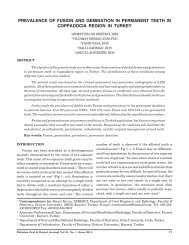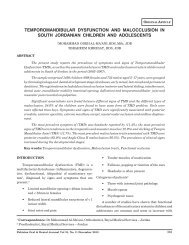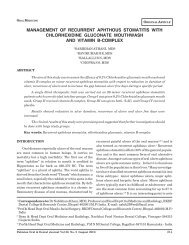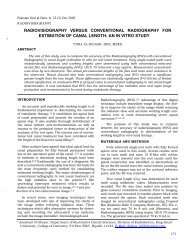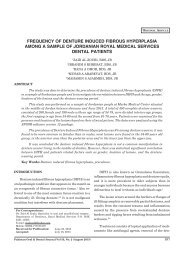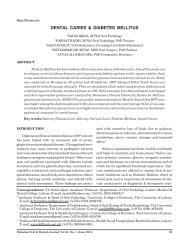Evaluation of Discolouration of Some Composite Restorative Materials
Evaluation of Discolouration of Some Composite Restorative Materials
Evaluation of Discolouration of Some Composite Restorative Materials
Create successful ePaper yourself
Turn your PDF publications into a flip-book with our unique Google optimized e-Paper software.
<strong>Evaluation</strong> <strong>of</strong> Discoloration od some <strong>Composite</strong> <strong>Restorative</strong> <strong>Materials</strong><br />
The different polishing systems were chosen because<br />
<strong>of</strong> their popular use in clinical practice. The<br />
mylar subgroup acted as the control as it has been<br />
generally accepted that composite resin cured under a<br />
mylar strip would produce the smoothest surface. It<br />
has been found that the surface cured directly in<br />
contact with mylar discoloured more than the polished<br />
surface. 26, 27 This was true only for Silux Plus specimens<br />
cured under the mylar strip which discoloured more<br />
than those in the S<strong>of</strong>lex and Enhance subgroups at a<br />
visually perceptible level. Filtek Z-250 specimens, on<br />
other hand cured under the mylar strip registered the<br />
lowest DE value among the subgroups. The difference<br />
in the type <strong>of</strong> composite resin may explain these<br />
findings. It should also be noted that the studies cited<br />
were made in the 1970’s and 1980’s where improvement<br />
on composite resin chemistry is not comparable<br />
to the materials that are available to us today. The<br />
strain that is caused on the surface <strong>of</strong> composite cured<br />
against the mylar strip increases the activity <strong>of</strong> the<br />
atoms on the surface and facilitates accumulation <strong>of</strong><br />
stains. It has been previously found that when the<br />
resin rich layer was removed by polishing with S<strong>of</strong>lex<br />
disks the discoloration was reduced.<br />
Every component <strong>of</strong> resin may be implicated in<br />
discoloration. The resin matrix plays major part in the<br />
colour stability <strong>of</strong> composites. The high viscosity <strong>of</strong><br />
resin matrix is reduced by proper mixture <strong>of</strong> diluent, to<br />
help incorporate more filler loading. The variation in<br />
the water sorption rate between materials using Bis-<br />
GMA matrix may be due to the different proportions <strong>of</strong><br />
diluent TEGDMA. 28 The addition <strong>of</strong> fillers reduces<br />
polymerisation shrinkage, coefficient <strong>of</strong> thermal expansion<br />
and water sorption. As for water sorption it<br />
has been shown that materials exhibiting high water<br />
sorption values are more easily stained by hydrophilic<br />
colourings in aqueous solutions, the water presumably<br />
acting as a penetrating vehicle. The hydrophilic composites<br />
allow water to penetrate the matrix or filler<br />
matrix interface. 29,30, 31,32 In instances where both adsorption<br />
and absorption are known to exist and it is not<br />
clear which process predominates, the whole process is<br />
called as sorption. The staining may result from adsorption<br />
<strong>of</strong> stain on the surface <strong>of</strong> the composite 4<br />
following the absorption <strong>of</strong> water by the resin matrix. 33<br />
Pakistan Oral & Dental Journal Vol 29, No. 1, (June 2009)<br />
The least discoloration was found upon polishing<br />
with S<strong>of</strong>lex disks followed in ascending order by Enhance,<br />
mylar and diamond burs system (Table 3).<br />
There was a greater amount <strong>of</strong> discoloration in specimens<br />
polished with diamond instruments and cured<br />
under the mylar strip as compared to specimens polished<br />
with S<strong>of</strong>lex and Enhance. The difference in the<br />
discoloration (ΔE) in NBS units between the mylar and<br />
S<strong>of</strong>lex and mylar and Enhance were 1.36 and 1.06<br />
respectively, which is discernible by the naked eye. It<br />
has been shown that the resin matrix plays a major<br />
part in the colour stability <strong>of</strong> composites and water<br />
sorption rate is <strong>of</strong> particular importance. 34,35,36 The Bis-<br />
GMA matrix is a very viscous and bulky difunctional<br />
monomer. The high viscosity <strong>of</strong> Bis-GMA is reduced by<br />
the admixture <strong>of</strong> trietylene glycol dimethacrylate<br />
(TEGDMA), which is more reactive. The lower the<br />
viscosity <strong>of</strong> the monomer mixture, the more filler may<br />
be incorporated into the mixture. An increased filler<br />
content will decrease water sorption rate. 37 As the<br />
surface area to volume ratio <strong>of</strong> the colloidal particles in<br />
Silux Plus is quite high (52% wt), it is difficult to attain<br />
higher level <strong>of</strong> loading in composite resins containing<br />
larger fillers. This reduced size <strong>of</strong> pyrolytic silica and<br />
the consequently filler matrix contact may also account<br />
for the increased water sorption and staining<br />
phenomena. 38,39<br />
Silux Plus, a micr<strong>of</strong>illed composite resin used as a<br />
control among the composites, performed as expected.<br />
It contains Bis-GMA as a matrix and TEGDMA as a<br />
diluent. It uses pyrogenic silica as fillers distributed at<br />
a concentration <strong>of</strong> 52% by weight and increased water<br />
sorption.<br />
Clearfil AP-X is a midifilled hybrid type <strong>of</strong> composite<br />
resin. It contains Bis-GMA as a matrix and TEGDMA as<br />
a diluent. It uses barium glass as fillers distributed at a<br />
concentration <strong>of</strong> 85% by weight. The mean ΔE value was<br />
found to be lowest when the surface was polished with<br />
S<strong>of</strong>lex disks followed in ascending order by the mylar<br />
strip, Enhance and diamond polishing system (Table 4).<br />
The difference in colour <strong>of</strong> the specimens in the S<strong>of</strong>lex<br />
and mylar subgroups against the diamond subgroup was<br />
visually discernible. The ΔE <strong>of</strong> the specimens <strong>of</strong> the<br />
diamond subgroup (5.27) was more severe than those in<br />
the Enhance subgroup (3.06). The discoloration in the<br />
Enhance subgroup was not visually discernible to those<br />
specimens in the S<strong>of</strong>lex and mylar subgroups. The<br />
difference in the degree <strong>of</strong> discoloration is visually<br />
discernible. Seven out <strong>of</strong> 10 specimens polished with<br />
128



